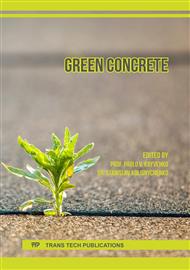p.216
p.222
p.228
p.233
p.239
p.246
p.253
p.262
p.267
Fresh and Mechanical Properties of Sustainable Concrete Using Recycled Aggregates
Abstract:
In the last few decades, the United Arab Emirates (UAE) witnessed rapid development in the construction industry. It was recently emphasized to adopt sustainability practice in all aspects related to construction. The recent sustainable practice that was enforced by Dubai Municipality in construction field is “greening the concrete” by solely replacing the Portland Cement with supplementary cementitious materials (SCMs), such as grand granulated blast furnace slag (GGBS) and fly ash. On the other hand, the use of recycled aggregates can also contribute to the greening of concrete and to the reduction of carbon foot print from the construction industry in the UAE. Consequently, it is significant to study the suitability of local available recycled aggregate and their effect on concrete fresh and hardened properties, in order to expand the current practice. The recycled aggregates, used in this investigation, are obtained from a local recycled aggregates plant in Abu Dhabi using concrete from demolished buildings in Abu Dhabi. The natural aggregates in concrete mixtures were replaced by recycled aggregates with the following percentages: 20%, 40%, 60% and 100%. The concrete parameters investigated are mainly the slump retention, rheology and compressive strength. The results are analyzed to arrive to pertinent conclusions for the utilization of concrete with recycled aggregates in different types of construction projects.
Info:
Periodical:
Pages:
239-245
Citation:
Online since:
May 2019
Authors:
Price:
Сopyright:
© 2019 Trans Tech Publications Ltd. All Rights Reserved
Share:
Citation:



